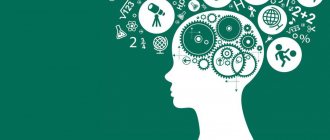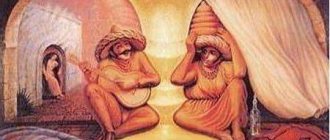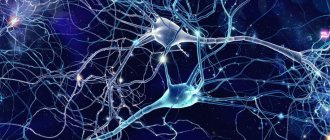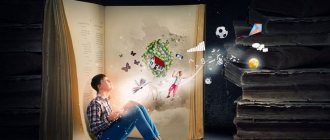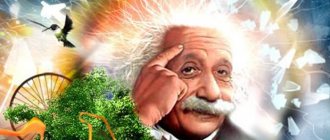Mental processes: perception, attention, imagination, memory, thinking, speech - act as the most important components of any human activity. In order to satisfy his needs, communicate, play, study and work, a person must perceive the world, pay attention to certain moments or components of activity, imagine what he needs to do, remember, think, and make judgments. Consequently, without the participation of mental processes, human activity is impossible; they act as its integral internal moments
Perception
– reflection of objects, situations or events in their integrity, which arises from the direct impact of objects on the senses. Perception is a set of sensations.
Feel
- processes of reflecting only individual objects of the surrounding world.
When a person holds a flower in his hand, the holistic impression of the flower is perception.
And separate sensations will be the aroma of a flower, the tactile impression of a hand holding a stem, that is, perception consists of 1 or several sensations that create a complete impression of an object.
For sensations to arise it is necessary:
1.object of external influence
2. analyzers capable of perceiving this influence.
Analyzer
- an anatomical and physiological apparatus specialized for receiving the effects of certain stimuli from the external and internal environment and processing them into sensations.
The analyzer consists of 3 main parts:
1. Receptor-peripheral part.
Receptors are nerve endings located above the sense organs that directly perceive external stimuli.
2. – Conducting pathways along which excitation is transmitted from the periphery to the center.
3. – The central part of the analyzer is the areas of the brain responsible for recognizing the corresponding stimulus. (visual, gustatory, etc.)
Mental operations
The main mental operations are distinguished:
- analysis,
- comparison,
- synthesis,
- generalization
- abstraction , etc.
► Analysis is a mental operation of dividing a complex object into its constituent parts or characteristics.
► Comparison is a mental operation based on establishing similarities and differences between objects.
► Synthesis is a mental operation that allows one to mentally move from parts to the whole in a single process.
► Generalization is the mental unification of objects and phenomena according to their common and essential characteristics.
► Abstraction (distraction) is a mental operation based on highlighting the essential properties and connections of an object and abstracting from other, unimportant ones.
Characteristics of imagination
Imagination is a special form of human life, standing apart from other technical processes and at the same time occupying an intermediate position between perception, thinking and memory.
Imagination is a special form of reflection, which consists of creating new images and ideas by processing existing ideas and concepts. Imagination develops along the lines of improving the operations of replacing real objects with imaginary ones and recreating imagination. The child gradually begins to create more and more complex images and their systems based on available descriptions and texts. The content of these images develops and enriches. Imagination becomes mediated and intentional.
In human life, imagination performs a number of specific functions. A.S. Vygotsky identifies three functions of imagination [Vygotsky L.S. Selected psychological studies - M., 1966]:
- Consistent. In order to evoke in a child a vivid idea of an object, it is necessary to find all the elements from which this idea will be built in real life.
- emotional. Each emotion has its own internal and external state, which means that fantasy is the apparatus that directly carries out the work of our emotions.
- Educational. In the game, the emotional function allows you to organize such forms of the environment that allow you to develop and realize your abilities. It can be seen that all the functions of the imagination are fully consistent with its psychological property - behavior aimed at forms that have not yet existed in our activity, and this emphasizes the need for the development of imagination.
Imagination is characteristically associated with the activity of the whole organism, being at the same time the most “mental” of all mental processes and states. It is nothing other than imagination that reveals the ideal and mysterious nature of the psyche. Thanks to imagination, a person creates, intelligently plans and manages his activities. Almost all of man's material and spiritual culture is a product of his imagination and creativity. Imagination takes a person beyond his immediate existence, reminds him of the past, and opens up the future. Possessing a rich imagination, a person can “live” in different times.
Imagination is the mental process of creating images of objects and situations by bringing a person’s existing knowledge into a new combination.
Thanks to imagination, a person creates, intelligently plans and manages his activities. Almost all of humanity's material and spiritual culture is a product of people's imagination and creativity. Imagination takes a person beyond his immediate existence, reminds him of the past, and opens up the future. Possessing a rich imagination, a person can “live” in different times, which no living creature in the world can afford.
Imagination differs from perception in that images do not always correspond to reality; they contain elements of fantasy, if the imagination draws pictures to the consciousness that nothing or little corresponds to. In reality this is called fantasy. If, in addition, the imagination is directed towards the future, then this is called a dream.
Imagination can be: involuntary or passive: dreams, day dreams, hallucinations (auditory and visual); voluntary or active imagination: recreative or reproductive and creative, musical. Creativity includes dreams and fantasies.
Active imagination is characterized by the fact that, using it, a person, at his own request, by force of will, evokes appropriate images. Active imagination includes creative and musical imagination.
Creative imagination is a type of imagination in which a person independently creates new images and ideas that have value for other people or society as a whole and are embodied (“crystallized”) in specific original products of activity. Images of creative imagination are created using various techniques and intellectual operations. In the structure of creative imagination, there are two types of such intellectual operations:
1st type of operations through which ideal images are formed;
2nd type of operations, on the basis of which finished products are processed
Interaction of attention and memory
Without such important psychological processes as memory and attention, normal human life is practically impossible. These processes help to receive information from the outside world and retain it for a long time.
All human mental activity relies on memory. Memory helps us revive past experiences, knowledge, phenomena, images in our minds. The most dynamic development of memory occurs at school age.
The problem of interaction between memory and attention is one of the most pressing in modern psychology. How well a person remembers information depends on how attentive he is. Attention allows a person to successfully perform his work and control external conditions.
Note 3
It should be noted that when one of these functions decreases, the second also begins to suffer.
Ways to build new images
The transformation of reality in the imagination is carried out by methods; called "techniques" of imagination . These include:
Combination , the combination of data in the experience of elements in new, more or less unusual combinations. This is the simplest technique of imagination, and it is what researchers of the past had in mind when they considered associations to be the mechanism of imagination.
Agglutination, a combination option in which a non-random set of traits is subject to combination, undergoes a direct selection of them according to a specific plan, concept.
Accentuation , emphasizing certain features of a phenomenon, which transforms its overall appearance. It should highlight the characteristic, essential, important.
Hyperbole and litotes - Changes in magnitude, quantitative growth and decrease - are special options for emphasis (very large or very small in relation to reality are emphasized. When in the imagination there is immediately an increase in some sides and a decrease in others, we are talking about polarization.
Idealization , The construction of idealized images free from all petty things, which sometimes cause the illusion of exclusivity and perfection of a certain phenomenon. The main essence of dreams lies in the pursuit of ideal.
Typification , Specific generalization. Through the concrete in the image that appears to the type, the generally significant is highlighted.
Alegorization, Creation of allegory - the use of an image in a figurative sense. An image acts only as a conventionally chosen sign of some phenomenon of reality.
Metaphorization , Construction of metaphors. A metaphor is a deeper mental representation of a phenomenon than an allegory, since there is a certain similarity and analogy between the metaphorical image and its meaning.
Symbolization , the use of symbols, is the most profound, essential filling of the imagination technique. Understanding the language of symbols helps a person consciously receive messages from his own unconscious (dreams, etc.). A symbol differs from a sign in that it is not conventionally chosen to designate, but is deeply, essentially united with what it denotes. Unlike a concept, a symbol has an unlimited amount of meaning. Only the universal, due to the very way of human existence, can be expressed through symbols.
In the technique of imagination, a complex dynamic unity of the conscious and unconscious is always created.
Interaction of memory and speech
Speech and memory are closely related. If memory and speech function properly, a person can share experiences and reproduce accumulated knowledge and skills. Speech is a mental process, the highest mental function that ensures communication between people. Memory, in turn, accumulates, stores, and then reproduces previously received information. It should be noted that it is speech and, along with it, memory that actively develops in preschool age.
It should be noted that speech is largely associated with logical memory. It is easier to remember what was expressed in linguistic form.
Speech helps sensory memory, which most often does not last long.
When a person perceives or generates speech, he turns to his memory. Without memory, a person would not be able to communicate, since he would not remember the meaning of words.
